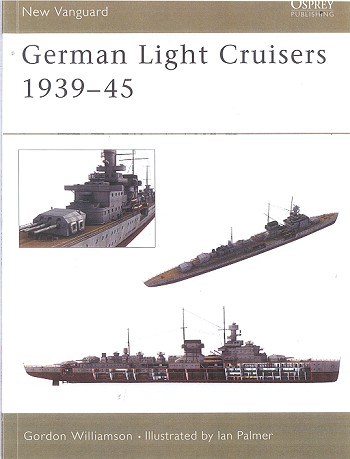 When Osprey, known for decades for their famous
Man-At-Arms series on units and uniforms...branched off into the New
Vanguard series, which included ships, military history enthusiasts and
scale modelers had reason to rejoice. Many subjects heretofore unaddressed or
only lightly so, were given their own volumes.
When Osprey, known for decades for their famous
Man-At-Arms series on units and uniforms...branched off into the New
Vanguard series, which included ships, military history enthusiasts and
scale modelers had reason to rejoice. Many subjects heretofore unaddressed or
only lightly so, were given their own volumes.
Though not a Deutsches Kriegsmarine (DKM, WW II German navy) enthusiast, the
concept of books on specific DKM ship classes WAS intriguing. Therefore, Gordon
Williamson's German Light Cruisers 1939-45 from Osprey was a
must-purchase. "Competition" on the subject is to all practical purposes
nonexistent. Koop and Schmolke's magnificent volume on DKM CLs is put of print
and triple the Osprey's price. The (excellent) two-volume Marek Ciesla /
Waldemar Danielwicz books are in Polish text and cover only the "K" class.
Ian Palmer's "Osprey style" illustrations are excellent. The 8 pages of
colour artwork alone are worth the volume's price. 'Twould have happily paid an
extra buck for the cutaway hull illustration to be a fold-out in maybe 1/400
scale, rather than 700th or so and partially hidden in the binding.
When the German light cruisers were constructed, parallel with the "pocket
battleships" (Panzerschiffe) and before the three classes of heavy ships
(Scharnhorst class battlecruisers, Admiral Hipper class heavy
cruisers and Bismarck class battleships), the six (6) DKM light cruisers
comprised no less than four "classes!"
This small number of units built allowed the author to address each ship
separately, definitely of value to readers.
Sadly, though Germany's most famous (and successful) surface ship (and class,
for that matter) of WW I was the light cruiser Emden, the DKM seemed to
lose their focus...and the German light cruisers of WW II became the least
successful of their large ship types, though most "numerous." 'Quite an irony,
as the British, Americans and (to a lesser extent) imperial navies used their
light cruisers constantly and aggressively.
DKM light cruisers used a variant of the 88mm (8.8cm / 3.46 inch) gun as
their heavy antiaircraft / secondary battery. In the Emden (II) and early
"K" class, mounts were single pedestal, shielded, manually operated, a
maximum of 6 barrels (according to volumes on the DKM by H.T. Lenton, J.C.
Taylor and Richard Humble). As (surviving) ships were upgraded, heavy AA became
the (problematic tri-axial) open twin mount, retaining the 8.8cm calibre
weapon.
Compliment is shown as 483 officers and sailors for the (6,990 ton) Emden
II, 850 for (8,427 ton) Leipzig and 896 for (9,040 ton)
Nurnberg, but individually, 1,550 for each of the (6750 ton) "K" class, a
crew more appropriate for the 15,000 ton Admiral Hipper class heavy
cruisers).
In the three "K" class', Leipzig and Nurnberg's specifications boxes, the
secondary armament (12 x 10.5 cm) figures appear to also belong to the heavy
cruisers. According to Lenton, Taylor and Humble, secondary armament was 6 (3
open twin mounts) 8.8cm and a compliment of about 820 for the "K" class
ships. Buyers may elect to make notes in the questionable areas and enjoy
the rest of the volume.
Sadly, there are no plastic kits of DKM Leichte Kreuzers, though there is a
1/250 card model of Leipzig marketed by Paper Models International. (Your
editor would like to mention that there are a number of reasonably priced resin
kits available and would like to plug 7th
Kompany and WSW kits as a good place to start.)
Highly recommended for the WW II nautical enthusiast.
Review copy courtesy of the reviewer's chequebook.
Reviewed by James Hood
For Scott Van Aken's Modeling Madness review
of James Hood's novel,
Adventure--Into The Neverland, go to: http://users3.ev1.net/~bjmonkeyandcj/James_Hood.htm
January 2005
If you would like your product reviewed fairly
and quickly by a site that has nearly 300,000 visitors a month, please contact me or see other details in the Note to Contributors.
 When Osprey, known for decades for their famous
Man-At-Arms series on units and uniforms...branched off into the New
Vanguard series, which included ships, military history enthusiasts and
scale modelers had reason to rejoice. Many subjects heretofore unaddressed or
only lightly so, were given their own volumes.
When Osprey, known for decades for their famous
Man-At-Arms series on units and uniforms...branched off into the New
Vanguard series, which included ships, military history enthusiasts and
scale modelers had reason to rejoice. Many subjects heretofore unaddressed or
only lightly so, were given their own volumes.